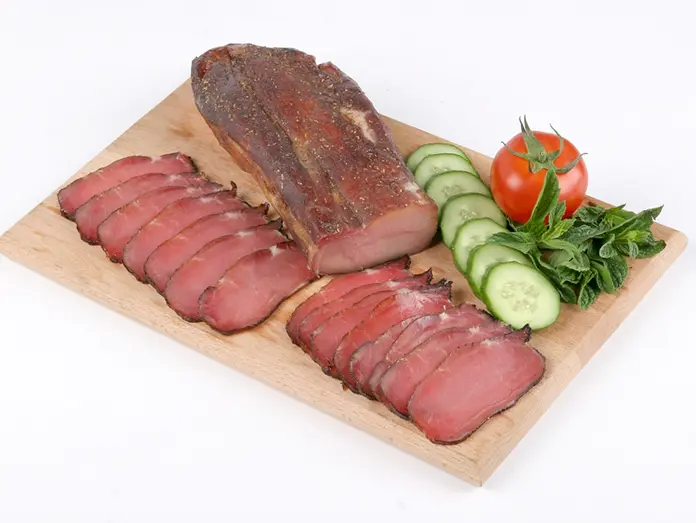When it comes to convenience, few foods can beat cold cuts. These thin slices of cooked, ready-to-eat meat are served cold, making them a popular choice for sandwiches and snacking. Cold cuts, also known as deli meats, lunch meats, sandwich meats, or sliced meats, are a staple in many households.
What are Cold Cuts?
Cold cuts are classified as processed meats. This means that the meat has been preserved through methods such as curing, salting, smoking, or the addition of chemical preservatives. There are three main types of cold cuts:
- Whole cuts: These are cooked cuts of meat that are then sliced. Examples include sliced turkey breast, roast chicken, and lean roast beef.
- Restructured meats: These are meats that have been sectioned and formed into a single piece. They are made by combining pieces or chunks of meat. Multi-part cooked hams or turkey breasts are examples of restructured meats.
- Processed sausages: These are cold cuts that have been formed into a symmetrical shape after being chopped and seasoned. Salami, hot dogs, bologna, sausage, and pastrami are all examples of processed sausages.
Cold cuts can be purchased pre-packaged or sliced to order at a deli counter. The most commonly eaten cold cuts in the U.S. include deli ham, turkey, and roast beef.
Nutritional Considerations
Cold cuts are a good source of protein, iron, zinc, and vitamin B1However, they are also high in saturated fat and sodium. It is important to be mindful of these factors, especially if you have high blood pressure or heart disease. The sodium nitrate added to cold cuts as a preservative can contribute to high sodium intake. Some manufacturers use celery powder as a natural alternative to sodium nitrate.

Under USDA standards, cold cuts labeled organic cannot contain synthetic preservatives. Substitutions such as beet and celery powder are commonly used. It is recommended that adults consume less than 2,300 mg of sodium per day, but most people exceed this amount. Proper storage and adherence to food safety guidelines are important to prevent the growth of bacteria, including Listeria.
Storage and Food Safety
Once opened, cold cuts typically last 3 to 5 days, even with preservatives. Freshly sliced cold cuts from a deli should be consumed within 1 to 3 days if stored properly. It is recommended to store cold cuts in an airtight container or plastic bag in the coldest part of the refrigerator. Alternatively, they can be frozen for longer storage.
Listeria is a common concern with cold cuts. It can grow at refrigerator temperatures where other bacteria cannot. To ensure food safety, it is important to discard cold cuts if they feel sticky or slimy, have a sour or rancid smell, show discolorations or mold, or if you are in doubt about their freshness.

Healthier Options
If you enjoy cold cuts but want to make healthier choices, consider the following options:
- Buy reduced- or low-sodium cold cuts.
- Look for meats that are raised without antibiotics.
- Opt for sugar-free cold cuts.
- Choose nitrate/nitrite-free cold cuts.
- Purchase unprocessed meats, which are not as strongly linked to chronic diseases.
- Add more vegetables to your sandwiches and wraps, and use less meat.
- Consider your overall diet and sodium intake. If you consume other high-sodium foods, make swaps accordingly to decrease your consumption of cold cuts.
Remember, cold cuts can still be enjoyed occasionally as part of a balanced diet. By refrigerating them properly and making informed choices, you can continue to enjoy the convenience and deliciousness that cold cuts offer.
Smoked cold cuts are a convenient and tasty option for sandwiches and snacks. However, it is important to be mindful of their nutritional content, especially the sodium and saturated fat levels. By choosing healthier options and properly storing and handling cold cuts, you can continue to enjoy them as part of a balanced diet. Remember to prioritize food safety and discard any cold cuts that show signs of spoilage. With these considerations in mind, you can savor the flavors and convenience of smoked cold cuts while making healthier choices.
What are cold cuts?
Cold cuts are thin slices of cooked, ready-to-eat meat that are served cold. They are also known as deli meats, lunch meats, sandwich meats, or sliced meats.
What types of cold cuts are there?
There are three main types of cold cuts: whole cuts, restructured meats, and processed sausages.
Are cold cuts healthy?
Cold cuts can be high in protein, iron, zinc, and vitamin B12, but they are also high in saturated fat and sodium. It is important to be mindful of these factors, especially if you have high blood pressure or heart disease.
How should I store cold cuts?
Cold cuts should be stored in an airtight container or plastic bag in the coldest part of the refrigerator. They can also be frozen for longer storage.
What are some healthier options to traditional cold cuts?
Some healthier options include buying reduced- or low-sodium cold cuts, choosing meats that are raised without antibiotics, opting for sugar-free cold cuts, and selecting nitrate/nitrite-free options. Adding more vegetables to sandwiches and wraps and reducing the amount of meat used is also a good choice.
Can I still enjoy cold cuts occasionally?
Yes, cold cuts can still be enjoyed occasionally as part of a balanced diet. By making informed choices and refrigerating them properly, you can continue to enjoy the convenience and deliciousness that cold cuts offer.
References
Hayman, V. (2021). Smoked Cold Cuts: A Delicious and Convenient Option. University of Wyoming Extension.
If you want to know other articles similar to Smoked cold cuts: convenient & delicious option you can visit the Deli meats category.


Related Articles